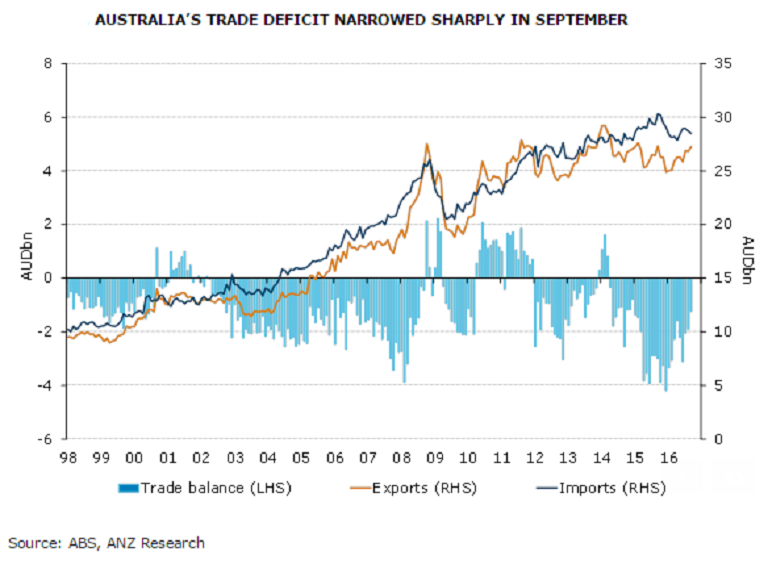Australia’s trade balance improved during the month of September, driven by strong exports of coal and significantly beating market expectations. This surprise improvement was driven by a spike in resource exports, with consumer imports being a little weaker, leading to the decline.
The Australian trade deficit narrowed to AUD1.23 billion in September from an upwardly revised AUD1.89 billion in August, much better than the market consensus. Total exports rose 1.6 percent in September, with the increase concentrated in resource exports. However, gold exports, which tend to be very volatile, dropped a sizeable 19 percent in the month.
Exports excluding gold bounced a strong 4.0 percent in September. This strength in exports was largely driven by a rise in other resource exports, which were up 3.9 percent in September. While iron ore exports were unchanged, the value of coking exports spiked, up a sharp 12.1 percent, likely underpinned by strong price gains. LNG exports continued to rise at a moderate rate.
Imports dropped slightly, down 0.8 percent in September. The prime driver was weaker imports of consumption goods, down 2.8 percent, while capital goods imports (ex-aircraft) were marginally higher, up 0.2 percent in the month and intermediate goods rose a solid 2.2 percent.
Despite the stronger exchange rate, net tourism and education exports continued to increase at a solid rate, up 4 percent in September. The Reserve Bank of Australia maintained its key benchmark rate at a record low of 1.50 percent in its November 1 monetary policy meeting, judging that unchanged policy is consistent with growth and inflation targets.
Meanwhile, the benchmark Australia's S&P/ASX 200 index traded 0.65 percent higher at 5,197.5 by 05:00 GMT.



 Asian Currencies Steady as Rupee Hits Record Low Amid Fed Rate Cut Bets
Asian Currencies Steady as Rupee Hits Record Low Amid Fed Rate Cut Bets  South Korea Posts Stronger-Than-Expected 1.3% Economic Growth in Q3
South Korea Posts Stronger-Than-Expected 1.3% Economic Growth in Q3  U.S. Cyber Monday Online Sales Surge Past $9.1 Billion as Holiday Shopping Momentum Builds
U.S. Cyber Monday Online Sales Surge Past $9.1 Billion as Holiday Shopping Momentum Builds  Dollar Slides to Five-Week Low as Asian Stocks Struggle and Markets Bet on Fed Rate Cut
Dollar Slides to Five-Week Low as Asian Stocks Struggle and Markets Bet on Fed Rate Cut  RBA Signals Possible Rate Implications as Inflation Proves More Persistent
RBA Signals Possible Rate Implications as Inflation Proves More Persistent  Tech Stocks Lift S&P 500 as Fed Rate-Cut Expectations Rise
Tech Stocks Lift S&P 500 as Fed Rate-Cut Expectations Rise  China’s Services Sector Posts Slowest Growth in Five Months as Demand Softens
China’s Services Sector Posts Slowest Growth in Five Months as Demand Softens  Trump and Lula Discuss Trade, Sanctions, and Security in “Productive” Phone Call
Trump and Lula Discuss Trade, Sanctions, and Security in “Productive” Phone Call  Dollar Holds Steady as Markets Shift Focus to 2026 Rate Cut Expectations
Dollar Holds Steady as Markets Shift Focus to 2026 Rate Cut Expectations 





























